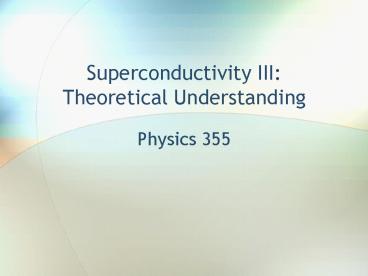Superconductivity III: Theoretical Understanding - PowerPoint PPT Presentation
1 / 12
Title:
Superconductivity III: Theoretical Understanding
Description:
* * * Phenomenological Model to explain the Meissner Effect. * * Title: Superconductivity Author: David Marx Last modified by: David Created Date: 4/30/2005 9:44:33 PM – PowerPoint PPT presentation
Number of Views:215
Avg rating:3.0/5.0
Title: Superconductivity III: Theoretical Understanding
1
Superconductivity IIITheoretical Understanding
- Physics 355
2
Superelectrons
- Two Fluid Model
3
London Phenomenological Approach
- Ohms Law
- Magnetic Vector Potential
- Maxwell IV
- London Equation
4
London Penetration Depth
The penetration depth for pure metals is in the
range of 10-100 nm.
5
Coherence Length
- Another characteristic length that is independent
of the London penetration depth is the coherence
length ?. - It is a measure of the distance within which the
SC electron concentration doesnt change under a
spatially varying magnetic field.
6
(No Transcript)
7
The effects of lattice vibrations
The localised deformations of the lattice caused
by the electrons are subject to the same spring
constants that cause coherent lattice
vibrations, so their characteristic frequencies
will be similar to the phonon frequencies in the
lattice
The Coulomb repulsion term is effectively
instantaneous
If an electron is scattered from state k to k by
a phonon, conservation of momentum requires that
the phonon momentum must be q p1 ? p1
The characteristic frequency of the phonon must
then be the phonon frequency ?q,
Lecture 12
8
The attractive potential
This shows that the phonon mediated interaction
is of the same order of magnitude as the Coulomb
interaction
The maximum phonon frequency is defined by the
Debye energy h?D kB?D, where ?D is the Debye
temperature (100-500K)
The cut-off energy in Coopers attractive
potential can therefore be identified with the
phonon cut-off energy h?D
Lecture 12
9
The maximum (BCS) transition temperature
?ep can be estimated from band structure
calculations and from estimates of the frequency
dependent Fourier transform of the interaction
potential, i.e. V(q, ?) evaluated at the Debye
momentum.
Typically ?ep 0.33
For Al calculated ?ep 0.23 measured ?ep
0.175 For Nb calculated ?ep 0. 35 measured
?ep 0.32
which implies a maximum possible Tc of 25K !
Lecture 12
10
(No Transcript)
11
Bardeen Cooper Schreiffer Theory
In principle we should now proceed to a full
treatment of BCS Theory
However, the extension of Coopers treatment of a
single electron pair to an N-electron problem
(involving second quantisation) is a little too
detailed for this course
Physical Review, 108, 1175 (1957)
Lecture 12
12
(No Transcript)































